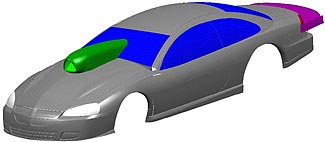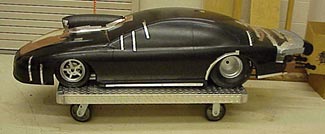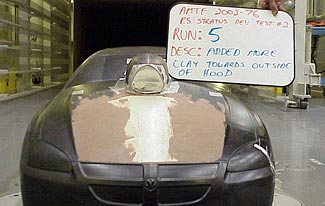|
<<
PREVIOUS PAGE
This is significant when one recalls the incident
of Warren Johnson covertly measuring Larry Morgan's
new Stratus during testing at Las Vegas last
February; nothing more was said because the
car was legal.
"A Pro Stock car wants just enough down-force
in the front to steer it, and just enough in
the rear to keep the tires planted, so they
won't spin on the gear changes," says DeKoninck.
Also, the rear tires need to be packaged into
the back section of the car under specific guidelines;
NHRA has over 20 reference points they use to
verify a Pro Stock car against a production
model.
Similar to the previous funny car effort, CATIA
files were used to generate a 3/8-scale version
of the Stratus design.
 |
Here is a picture
of the Stratus in CATIA. The program allows
the car to be viewed from every possible
angle. |
| Ready to go to work; you
gotta love the '200-mph' duct tape, which
is going to get a real torture test in the
wind tunnel. |
 |
 |
As the board
says, this is Pro Stock Stratus development
test #2, run #5, and the change is more
clay added to the outer edges of the hood. |
A Pro Stock Neon model was also CATIA-built,
using laser scanning (surface-scanning an existing
Pro Stocker) and then constructed to verify
data. DeKoninck and the model builders and stylists
were under a great deal of pressure to complete
the effort for debut at the start of the 2003
season, but, when it was done, the aero numbers
on the new body
ADVERTISEMENT
 |
|
were
even better than those of the smaller Neon,
which had been designed primarily by hand. After
four full days in the tunnel, these changes,
which were verified as legal using a set of
3/8-scale NHRA-type body templates the designers
created, were returned to the CATIA program
using laser scanning.
Once finalized by NHRA, the CATIA design was
printed out from 20 different full-size angles,
and car builder Jerry Haas came to the Tech
Center to advise on cutting paths for the separate
panels (remember, the whole car was pictured),
flanging for assembly, and other construction-related
issues. Roush Composites again was called on
to cut the full-scale buck, and Haas began building
the first chassis using the drawings as a guide.
Like the funny car, the bodies are all carbon-fiber
or Kevlar, which requires vacuum-forming.
NEXT
PAGE >>
|